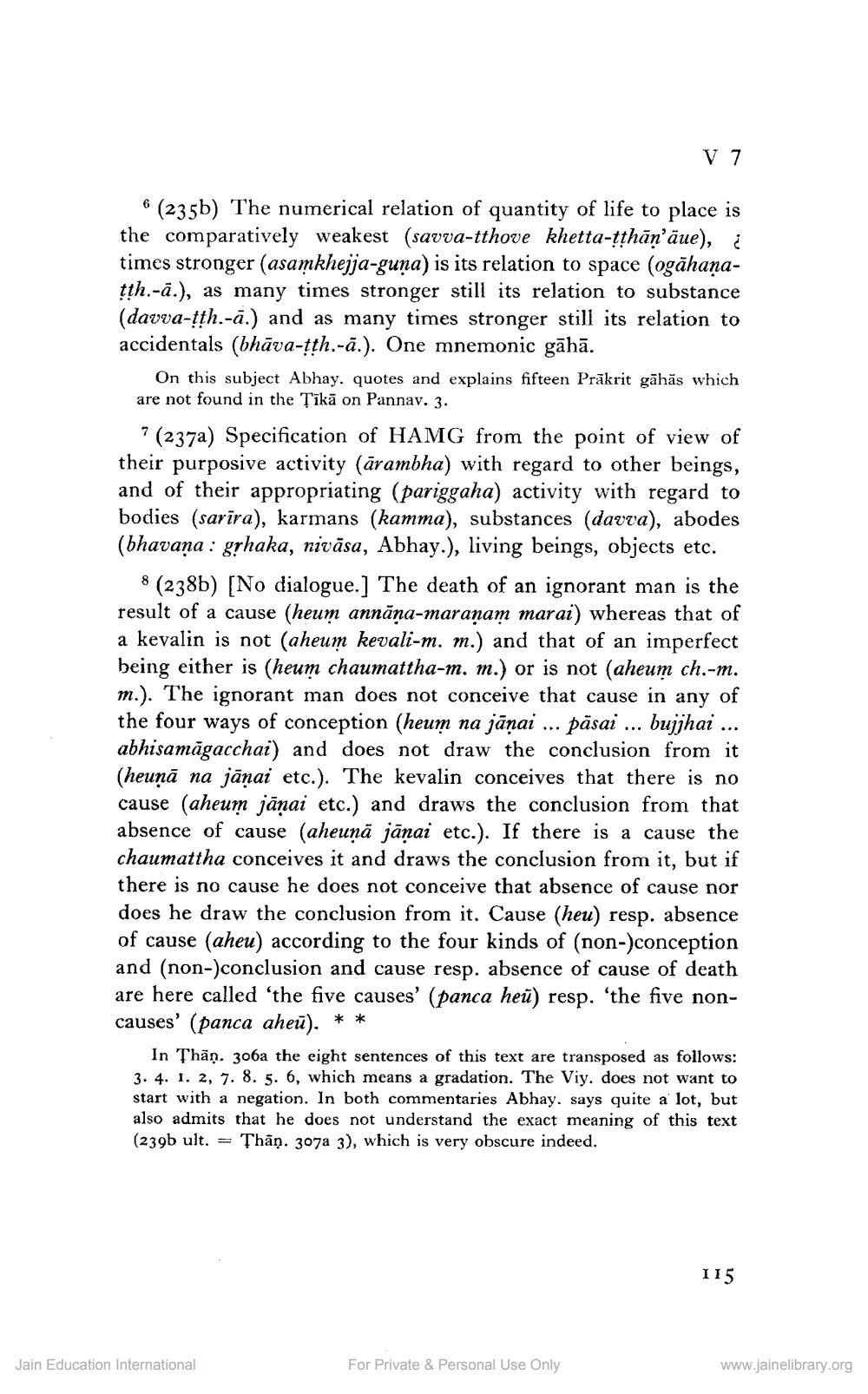Book Title: Agam 05 Ang 05 Bhagvati Vyakhya Prajnapti Sutra
Author(s): Jozef Deleu
Publisher: DE Tempel Brugge
View full book text
________________
V 7
© (235b) The numerical relation of quantity of life to place is the comparatively weakest (savva-tthove khetta-tthāņāue), į times stronger (asamkhejja-guna) is its relation to space (ogāhaņatth.-..), as many times stronger still its relation to substance (davva-tth.-..) and as many times stronger still its relation to accidentals (bhāva-th.-..). One mnemonic gāhā.
On this subject Abhay. quotes and explains fifteen Prākrit gāhās which are not found in the sīkā on Pannav. 3.
? (237a) Specification of HAMG from the point of view of their purposive activity (ārambha) with regard to other beings, and of their appropriating (pariggaha) activity with regard to bodies (sarīra), karmans (kamma), substances (davva), abodes (bhavaņa : gļhaka, nivāsa, Abhay.), living beings, objects etc.
8 (238b) [No dialogue.] The death of an ignorant man is the result of a cause (heum annāņa-maranam marai) whereas that of a kevalin is not (aheum kevali-m. m.) and that of an imperfect being either is (heum chaumattha-m. m.) or is not (aheum ch.-m. m.). The ignorant man does not conceive that cause in any of the four ways of conception (heum na jānai ... pāsai ... bujjhai ... abhisamāgacchai) and does not draw the conclusion from it (heuņā na jānai etc.). The kevalin conceives that there is no cause (aheum jānai etc.) and draws the conclusion from that absence of cause (aheunā jāņai etc.). If there is a cause the chaumattha conceives it and draws the conclusion from it, but if there is no cause he does not conceive that absence of cause nor does he draw the conclusion from it. Cause (heu) resp. absence of cause (aheu) according to the four kinds of (non-)conception and (non-)conclusion and cause resp. absence of cause of death are here called 'the five causes' (panca heū) resp. 'the five noncauses' (panca aheü). * *
In Thăn. 306а the eight sentences of this text are transposed as follows: 3. 4. 1. 2, 7. 8. 5. 6, which means a gradation. The Viy. does not want to start with a negation. In both commentaries Abhay, says quite a lot, but also admits that he does not understand the exact meaning of this text (239b ult. = Thān. 307a 3), which is very obscure indeed.
115
Jain Education International
For Private & Personal Use Only
www.jainelibrary.org

Page Navigation
1 ... 115 116 117 118 119 120 121 122 123 124 125 126 127 128 129 130 131 132 133 134 135 136 137 138 139 140 141 142 143 144 145 146 147 148 149 150 151 152 153 154 155 156 157 158 159 160 161 162 163 164 165 166 167 168 169 170 171 172 173 174 175 176 177 178 179 180 181 182 183 184 185 186 187 188 189 190 191 192 193 194 195 196 197 198 199 200 201 202 203 204 205 206 207 208 209 210 211 212 213 214 215 216 217 218 219 220 221 222 223 224 225 226 227 228 229 230 231 232 233 234 235 236 237 238 239 240 241 242 243 244 245 246 247 248 249 250 251 252 253 254 255 256 257 258 259 260 261 262 263 264 265 266 267 268 269 270 271 272 273 274 275 276 277 278 279 280 281 282 283 284 285 286 287 288 289 290 291 292 293 294 295 296 297 298 299 300 301 302 303 304 305 306 307 308 309 310 311 312 313 314 315 316 317 318 319 320 321 322 323 324 325 326 327 328 329 330 331 332 333 334 335 336 337 338 339 340 341 342 343 344 345 346 347 348 349 350 351 352 353 354 355 356 357 358 359 360 361 362 363 364 365 366 367 368 369 370 371 372
